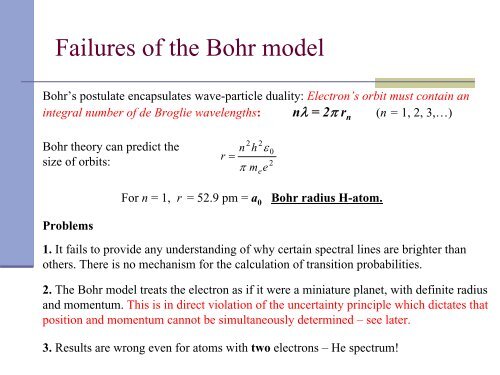The Quantum Theory of Atoms and Molecules - The Ritchie Group
The Quantum Theory of Atoms and Molecules - The Ritchie Group
The Quantum Theory of Atoms and Molecules - The Ritchie Group
You also want an ePaper? Increase the reach of your titles
YUMPU automatically turns print PDFs into web optimized ePapers that Google loves.
Failures <strong>of</strong> the Bohr model<br />
Bohr’s postulate encapsulates wave-particle duality: Electron’s orbit must contain an<br />
integral number <strong>of</strong> de Broglie wavelengths: nλ = 2π r n (n = 1, 2, 3,…)<br />
Bohr theory can predict the<br />
size <strong>of</strong> orbits:<br />
Problems<br />
r<br />
For n = 1, r = 52.9 pm = a 0 Bohr radius H-atom.<br />
1. It fails to provide any underst<strong>and</strong>ing <strong>of</strong> why certain spectral lines are brighter than<br />
others. <strong>The</strong>re is no mechanism for the calculation <strong>of</strong> transition probabilities.<br />
2. <strong>The</strong> Bohr model treats the electron as if it were a miniature planet, with definite radius<br />
<strong>and</strong> momentum. This is in direct violation <strong>of</strong> the uncertainty principle which dictates that<br />
position <strong>and</strong> momentum cannot be simultaneously determined – see later.<br />
3. Results are wrong even for atoms with two electrons – He spectrum!<br />
=<br />
n<br />
2<br />
h<br />
π m<br />
2<br />
e<br />
ε<br />
e<br />
0<br />
2


